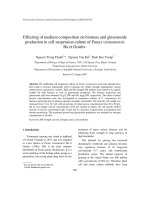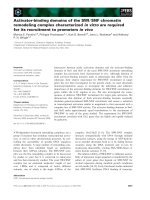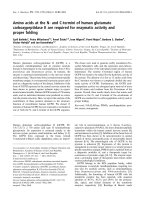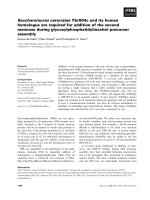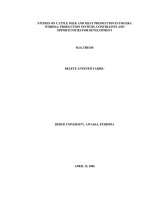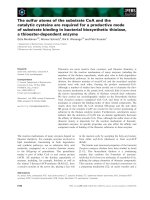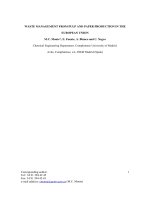Brutons tyrosine kinase and protein kinase c µ are required for TLR7 9 induced IKKα and IRF 1 activation and interferon β production in conventional dendritic cells
Bạn đang xem bản rút gọn của tài liệu. Xem và tải ngay bản đầy đủ của tài liệu tại đây (3.82 MB, 9 trang )
Bruton’s Tyrosine Kinase and Protein Kinase C
m
Are
Required for TLR7/9-Induced IKKa and IRF-1 Activation
and Interferon-b Production in Conventional Dendritic
Cells
Yan-Feng Li
1
, Koon-Guan Lee
1
, Xijun Ou
1
, Kong-Peng Lam
1,2,3,4
*
1 Immunology Group, Bioprocessing Technology Institute, Agency for Science, Technology and Research, Singapore, Singapore, 2 Department of Physiol ogy, Yong Loo
Lin School of Medicine, National University of Singapore, Singapore, Singapore, 3 Department of Microbiology, Yong Loo Lin School of Medicine, National University of
Singapore, Singapore, Singapore, 4 Department of Pediatrics, Yong Loo Lin School of Medicine, National University of Singapore, Singapore, Singapore
Abstract
Stimulation of TLR7/9 by their respective ligands leads to the activation of IkB kinase a (IKKa) and Interferon Regulatory
Factor 1 (IRF-1) and results in interferon (IFN)-b production in conventional dendritic cells (cDC). However, which other
signaling molecules are involved in IKKa and IRF-1 activation during TLR7/9 signaling pathway are not known. We and
others have shown that Bruton’s Tyrosine Kinase (BTK) played a part in TLR9-mediated cytokine production in B cells and
macrophages. However, it is unclear if BTK participates in TLR7/9-induced IFN-b production in cDC. In this study, we show
that BTK is required for IFN-b synthesis in cDC upon TLR7/9 stimulation and that stimulated BTK-deficient cDC are defective
in the induction of IKKa/b phosphorylation and IRF-1 activation. In addition, we demonstrate that Protein Kinase C
m (PKCm)
is also required for TLR7/9-induced IRF-1 activation and IFN-b upregulation in cDC and acts downstream of BTK. Taken
together, we have uncovered two new molecules, BTK and PKC
m, that are involved in TLR7/9-triggered IFN-b production in
cDC.
Citation: Li Y-F, Lee K-G, Ou X, Lam K-P (2014) Bruton’s Tyrosine Kinase and Protein Kinase C m Are Required for TLR7/9-Induced IKKa and IRF-1 Activation and
Interferon-b Production in Conventional Dendritic Cells. PLoS ONE 9(8): e105420. doi:10.1371/journal.pone.0105420
Editor: Luwen Zhang, University of Nebraska – Lincoln, United States of America
Received January 26, 2014; Accepted July 24, 2014; Published August 29, 2014
Copyright: ß 2014 Li et al. This is an open-access article distributed under the terms of the Creative Commons Attribution License, which permits unrestricted
use, distribution, and reproduction in any medium, provided the original author and source are credited.
Funding: Biomedical Research Council of the Singapore Agency for Science Technology and Research ( The funders had no role in
study design, data collection and analysis, decision to publish, or preparation of the manuscript.
Competing Interests: The authors have declared that no competing interests exist.
* Email:
Introduction
Conventional dendritic cells (cDC) and plasmacytoid dendritic
cells (pDC) recognize single-stranded (ss) RNA and unmethylated
CpG DNA via Toll-like receptors (TLR) 7 and 9, respectively, to
initiate innate immune responses against viruses and bacteria
[1,2,3,4]. TLR7 and TLR9 are endosome-bound, leucine-rich-
repeat containing type I transmembrane glycoproteins and they
signal via the adaptor MyD88 to induce the production of
proinflammatory cytokines and type I interferons (IFN) [2,5]. The
secretion of proinflammatory cytokines is dependent on the
activation of the transcription factor nuclear factor kB (NF-kB)
while the synthesis of type I IFN is dependent on the combined
activation of NF-kB and IFN regulatory factors (IRF) [6,7]. The
IRF family of transcription factors comprises nine members (IRF-
1–9), and which IRF is activated depends on the specific cell type
involved. For instance, pDC rapidly produce high amounts of
IFN-a through the induction of the transcription factor IRF-7
[8,9,10], whereas IRF-1 is activated and translocated to the
nucleus to induce IFN-b systhesis in cDC [11,12].
IkB kinase a (IKKa) has been shown to associate and activate
IRF-1 during TLR7/9 signaling in cDC [12] and acts specifically
via IRFs to induce the production of IFN. Given the importance of
TLRs in host defense against pathogens, dissection of TLR7/9
signaling pathways becomes an important research focus. How-
ever, the TLR7/9 signaling pathway leading to IKKa and IRF-1
activation in cDC has been relatively unexplored and it is
currently not known which other signaling molecules participate in
TLR7/9-signaling leading to IRF-1 activation and IFN-b
synthesis. Thus in this current study, we set out to determine the
upstream signaling molecules that might play a role in TLR7/9-
induced activation of IKKa and IRF-1 leading to IFN-b
production.
Bruton’s tyrosine kinase (BTK) is a member of the Tec family of
protein tyrosine kinases and has previously been shown to play
important roles in B cell development, activation and survival.
Mutations in BTK are known to lead to X-linked agammaglob-
ulinemia (XLA) in humans and X-linked immunodeficiency (xid)in
mice [13]. BTK has been shown to be activated by B cell antigen
receptor (BCR) [14], cytokine receptors [15,16], as well as TLR
[17,18,19,20] engagement. It is well documented that TLR-
induced NF-kB activation is defective in BTK-deficient cells
[21,22,23]. We and others also demonstrated that BTK played a
critical role in MyD88-dependent TLR-signaling of proinflamma-
tory cytokine production in B cells [17], macrophages [18,20] and
CDC [24,25]. In addition, we recently showed that BTK is
required to phosphorylate TLR3 for IFN-b production [26].
PLOS ONE | www.plosone.org 1 August 2014 | Volume 9 | Issue 8 | e105420
However, it is unclear if BTK plays a role in TLR7/9-induction of
IFN-b synthesis in
CDC.
In addition to BTK, it is conceivable that other signaling
molecules could contribute to TLR7/9-induced IFN-b produc-
tion. Various PKCs have been found to be important for TLR-
induced production of proinflammatory cytokines [27,28] and
PKCa has been shown to be involved in TLR3-induced IFN-b
synthesis [29]. Protein Kinase C (PKC) is a class of serine/
threonine kinase that is subdivided into three main groups, namely
conventional PKCs, novel PKCs, and atypical PKC [30,31].
Protein kinases D, consisting of PKD1 (also known as PKC
m),
PKD2, and PKD3, are extended family members of PKC [32]. It
is also not clear currently whether PKC participates, and if so,
which PKC member is involved in TLR7/9-induced IFN-b
production in
CDC. In this paper, we undertook to examine if
both BTK and PKC are involved in TLR-7/9 activation of IFN-b
production in cDC.
Materials and Methods
Ethics statement
All experiments and procedures were performed in compliance
with Guidelines on the Care and Use of Animals for Scientific
Purposes of the National Advisory Committee for Laboratory
Animal Research (NACLAR) of Singapore. The protocol was
approved by the Institutional Animal Care and Use Committee of
the Biological Resource Center (BRC) of Agency for Science,
Technology and Research (A*STAR) (Authorized IACUC No
110611). Steps were taken to minimize animal suffering.
Mice
Wild type C57BL/6 mice were obtained from the BRC, and
btk
2/2
mice were obtained from The Jackson Laboratory.
Cells and transfection
Conventional dendritic cells (CDC) were differentiated as
described [33,34]. Briefly, bone marrow (BM) cells were cultured
in Dulbecco’s modified Eagle’s medium (DMEM) supplemented
with 100 units/ml penicillin, 100
mg/ml streptomycin, 2 mm l-
glutamine, 50
mm 2-mercaptoethanol, 10% heat-inactivated fetal
calf serum, and 1% supernatant of granulocyte-macrophage
colony-stimulating factor-transduced X-63 cells. After 6 to 7 days
of culture,
CDC were purified using anti-CD11c monoclonal
antibody-coupled magnetic beads (Miltenyl Biotech). For PKC
m
knock down studies, 5 mg of PKCm siRNA or scrambled siRNA
(Santa Cruz) were transfected into purified
CDC (1610
6
cells per
reaction) using Amaxa Nucleofector device and reagents as per
manufacturer’s instructions (Amaxa). Transfected
CDC were
maintained for an additional 24 h before stimulation.
Reagents
The following reagents were purchased and used in the study:
TLR7 agonist R848 and TLR9 ligand CpG-ODN 1668 (CpG)
(Invivogen); PKC inhibitors Go¨ 6976 and non-inhibitory analog
Go¨ 6983 (Calbiochem). Antibodies used for immunoblot analyses
were from Santa Cruz: anti-BTK, anti-IKKa/b, anti-PKC
m, anti-
IRF-1, anti-HDAC-1, anti-b-actin, donkey anti-goat IgG-horse-
radish peroxidase, goat anti-rabbit IgG-horseradish peroxidase,
and goat anti-mouse IgG-horseradish peroxidase; from Cell
Signaling: anti-phospho-BTK (Tyr
223
), anti-phospho-PKCm
(Ser
916
) and anti-phospho-IKKa (Ser
180
)/IKKb (Ser
181
). The
anti-phosphotyrosine horseradish peroxidase-conjugated antibody
(4G10) was from Upstate Biotech.
Immunoprecipitations and western blot analyses
Cells were treated for various times as shown with the indicated
stimuli, followed by immunoprecipitations and western blot
analyses as described previously [17]. 10 million wild type and
btk
2/2
CDC were plated onto 3cm dish, left untreated or
stimulated with R848 or CpG and then washed with cold PBS
and lysed on ice for 30 mins in 500
ml phospholysis buffer
containing 1% Nonidet P-40, 10 mM Tris-HCl, pH 8.0, 150 mM
NaCl, 1 mM EDTA, 0.2 mM Na
3
VO
4
, and a cocktail of protease
inhibitors (Roche). Whole cell lysates were obtained after
centrifugation at 13,000 rpm for 10 mins at 4uC. For immuno-
precipitation studies, cell lysates were pre-cleared with Protein A/
G Plus-agarose in the presence of goat IgG (Santa Cruz) for 1 h at
4uC. 3
mg of anti-BTK antibody and 20 ml beads were added to
the pre-cleared lysate and rotated for 3 h at 4uC. Subsequently,
beads were washed 3 times with phospholysis buffer and boiled in
loading buffer for 10 mins. For Western blot analyses, whole cell
lysates or immunoprecipitated proteins were electrophoresed in
10% SDS-polyacrylamide gels and transferred onto immunoblot
polyvinylidene difluoride membranes (Millipore). The membranes
were then probed with antibodies of interest (1:1000) and
normalized for total protein or b-actin. To examine nuclear
translocation of IRF-1, nuclear proteins from untreated or
stimulated wild type and btk
2/2
CDC were prepared using NE-
PER Nuclear and Cytoplasmic Extraction Reagents according to
manufacturer’s instruction (Pierce). Nuclear proteins were probed
with anti-IRF-1 and normalized with anti-HDAC-1 antibodies.
Measurement of IFN-b production by ELISA or
Quantitative RT-PCR
Cells were treated for 6 h with the indicated stimuli, and IFN-b
production was measured by ELISA as described [12]. Briefly,
untreated or CpG-stimulated wild type and btk
2/2
CDC cells were
cultured in 24-well plates at 1610
6
cells/ml. At 6 h poststimula-
tion, supernatants were harvested and stored at -20uCor
immediately assayed for cytokine production. The concentrations
of IFN-b were determined using commercial ELISA kit (PBL
Interferon Source) according to manufacturer’s instructions. For
quantification of IFN-b mRNA synthesis, total RNA was extracted
from wild type and btk
2/2
CDC at 2 h post-stimulation using
Trizol (Invitrogen), and cDNA was synthesized with Superscript II
reverse transcriptase as per manufacturer’s protocol (Invitrogen).
Quantitative PCR was performed on an Applied Biosystems 7500
real time PCR system using the following primers: IFN-b, 5’-
CAGCTCCAAGAAAGGACGAAC-3’ and 5’-GGCAGTG-
TAACTCTTCTGCAT-3’; b-actin, 59-AGATGACCCAGAT-
CATGTTTGAGA-39 and 59-CACAGCCTGGATGGC-
TACGTA-39.
Immunofluorescence
0.1 million WT or btk
2/2
cDC were plated on glass-bottomed
35 mm dish, stimulated for 1 h with R848 (1
mM) in the presence
or absence of Go¨ 6976 or Go¨ 6983 (30 min pre-treatment, 37uC)
and then fixed in 4% paraformaldehyde (5 min, RT), washed in
PBS, permeabilized with 1% Triton X-100 in PBS for 10 minutes
at RT and rinse well with PBS. The dish was then blocked with
3% BSA (1 h, RT). Cells were later incubated for 16 hrs at 4uC
with anti-IRF-1 antibody (1:50) in PBS containing 3% BSA. After
incubation with secondary anti-Rabbit IgG PE antibody (1:50,
1 h, RT), cells were washed and mounted with coverslips using
VECTASHIELD Mounting Medium with DAPI (Vector Labo-
ratories). Images of cells were taken and analyzed using an
BTK and PKCm in TLR7/9-Induced IFN-b Synthesis
PLOS ONE | www.plosone.org 2 August 2014 | Volume 9 | Issue 8 | e105420
Olympus Fluoview Version 2.1 software using 100X objectives
with oil.
Statistics
Statistical analysis was performed using Student’s t test (Prism).
p values of ,0.05 were considered significant.
Results
BTK is phosphorylated upon TLR7/9 engagement in
CDC
To determine if BTK is involved in TLR7/9 signaling, we
differentiated cDC from bone marrow (BM) precursors and
stimulated them with the TLR7 agonist R848 or the TLR9 ligand
CpG ODN-1668 (CpG) and examined if BTK is phosphorylated
upon TLR engagement. After treatment of wild type
CDC with
R848 or CpG, total BTK was immunoprecipitated and probed for
tyrosine phosphorylation using the phospho-tyrosine specific
antibody 4G10. As shown in Fig. 1A, BTK was activated, as
indicated by its tyrosine phosphorylation status upon stimulation
of
CDC with R848. Similarly, stimulation of CDC with CpG also
led to the phosphorylation of BTK (Fig. 1B). To confirm the
phosphorylation of BTK, the same cell lysates were also subjected
to immunoblot with anti-phospho-BTK (Y223) antibody. Consis-
tently we observed an increase in the amount of phosphorylated
BTK in cDC after treatment of these cells with either R848
(Fig. 1C) or CpG (Fig. 1D). Thus, these data indicated that BTK
was activated during TLR7/9 signaling in
CDC. This result adds
onto our previous demonstration of a role for BTK in TLR9
signaling in B cells [17] and other cell types [18,20,35,36]. In
addition, our current finding also demonstrates that BTK is
activated upon TLR7 stimulation in
CDC, which has not been
previously documented.
BTK is involved in IFN-b production following TLR7/9-
stimulation in
CDC
Signaling through TLR7/9 leads to the secretion of IFN-a in
plasmacytoid dendritic cell (pDC) [3,10] and IFN-b in
CDC [12].
Previously our laboratory has demonstrated that BTK played a
critical role in TLR9-induced production of proinflammatory
cytokines such as IL-6, IL-12 and TNF-a [17] in B cells. Here, we
asked if BTK participates in TLR7/9-induced production of IFN-
b in
CDC. As shown in Fig. 2, the synthesis of IFN-b mRNA was
highly induced in wild type
CDC when they were stimulated for
2 h with R848 (A) or CpG (B). By contrast, there was a significant
reduction of IFN-b mRNA induction in R848 or CpG-stimulated
btk
2/2
CDC. This finding was further confirmed when we
measured secreted IFN-b protein level via ELISA from CpG
stimulated btk
2/2
CDC (Fig. 2C). Hence, the data indicated that
BTK is important for TLR7/9-induced IFN-b production in
CDC.
Activation of IkB kinase a and IRF-1 is impaired in TLR7/9-
stimulated btk
2/2
CDC
So far, not much is known of the TLR7/9 signaling pathway
that leads to IFN-b production in
CDC. The only well-established
molecules in the activation process are IKKa that induces IRF-1
in
CDC [12] and IRF-7 in pDC [9,10]. BTK had previously been
reported to be required for IkB kinase activation in B lymphocytes
[21] and IRF-3 induction in macrophages [26]. However, it is not
known whether BTK plays a role in IKKa and IRF-1 activation in
CDC.
To investigate whether BTK is involved in the TLR7/9
signaling pathway leading to IKKa induction in
CDC, we
examined the activation of IKKa/b using an anti-phospho-
IKKa/b specific antibody. As shown in Fig. 3A, TLR7-induced
activation of IKKa/b was markedly attenuated in btk
2/2
CDC as
compared with wild type controls when these cells were treated
with R848 agonists. The reduced phosphorylation pattern of
IKKa/b was observed across the various time points examined.
Similar defects were also observed when btk
2/2
CDC were
stimulated with the TLR9-ligand, CpG (Fig. 3B). Hence, BTK is
critical for the optimal activation of IKKa/b during TLR7/9
engagement.
Figure 1. Bruton’s tyrosine kinase is phosphorylated upon TLR7/9 stimulation in cDC. Purified wild type CDC (10 million cells per 3 cm
dish) were untreated or stimulated for 5 mins with either (A) TLR7 agonist (R848, 1
mM) or (B) TLR9 ligand (CpG ODN-1668, 0.1 mM). Cells were then
lysed in 500
ml lysis buffer for 30 min on ice and BTK was immunoprecipitated and probed with anti-phospho-tyrosine antibody (pY, 4G10) and
reprobed with anti-BTK antibodies. Total lysates after R848 (C) or CpG (D) treatment were also immunoblotted with anti-phospho-BTK (Y223) and re-
probed with BTK antibodies for equal loading of BTK. Results shown are representative of three independent experiments. The intensities of the
bands were quantified by ImageJ and the ratio of 4G10 or phopspho-BTK (Y223) over BTK in each sample was then calculated and presented. *p ,
0.05, **p,0.005 (Student’s t test), compared to untreated cells.
doi:10.1371/journal.pone.0105420.g001
BTK and PKC
m in TLR7/9-Induced IFN-b Synthesis
PLOS ONE | www.plosone.org 3 August 2014 | Volume 9 | Issue 8 | e105420
Induction of IKKa in TLR7/9-activated CDC is known to lead
to the phosphorylation and nuclear translocation of IRF
transcription factors that drive the synthesis of type I IFNs
[10,12]. IFN-b gene expression is regulated by different IRF
family members in different cell types and upon different stimuli
[9,37].
CDC utilizes IRF-1 for TLR9-induced IFN-b production
[11,12,38]. To determine if the activation of IRF-1 was affected in
TLR7/9-stimulated btk
2/2
CDC, we examined the nuclear
translocation of IRF-1 in these cells. As shown in Fig. 3C, the
engagement of TLR7 by R848 led to the activation and nuclear
translocation of IRF-1 in wild type
CDC. By contrast, the
activation of IRF-1 was largely compromised in R848-treated
btk
2/2
CDC. Similar finding was also observed for CpG-stimulated
btk
2/2
CDC (Fig. 3D). Furthermore, when confocal imaging
microscopy was used to analyze IRF-1 localization, we observed
increased translocation of IRF-1 into the nucleus of cells after
R848 stimulation. By contrast, IRF-1 translocation to the nucleus
was not evident in btk
2/2
CDC (Fig. 3E). Collectively, our results
indicated that the signal transduced by BTK is required to activate
IKKa/b and subsequently, IRF-1 in TLR7/9-stimulated
CDC.
PKCm phosphorylation is impaired in TLR7/9-stimulated
btk
2/2
CDC
BTK is known to interact with a number of signaling molecules
in various immune and cytokine receptor signaling [39]. One of
these molecules is Protein Kinase C (PKC) [40]. Various PKC
isoforms are known to be involved in the signaling cascade leading
to NF-kB activation [41,42,43,44]. For example, PKCb is critical
for B cell-receptor induced IKK activation [43]. On the other
hand, PKCa has been shown to be important for MyD88-
dependent TLR signaling leading to proinflammatory cytokine
production in DC [27] and for TLR3-induced IRF-3 activation
and IFN-b synthesis [29]. PKC
m (PKD1) has also been shown to
be important for TLR9 [45] and other MyD88-dependent TLR
signaling of pro-inflammatory cytokine production in
CDC [46].
However, in all these studies, it is not clear if PKC
m is activated
during TLR7/9 signaling and if it played a role in TLR7/9-
induced IFN-b production and if BTK has a role in the activation
of PKC
m.
First, to determine if any PKC would be involved and acts
downstream of BTK in TLR7/9-induced activation of IFN-b
production, we examined if the activation of any of the PKC
isoforms would be compromised in R848 or CpG-stimulated btk
2/2
CDC. Surprisingly, PKCa/b phosphorylation was found to be
comparable between TLR7-stimulated wild type and btk
2/2
CDC
(Fig. 4A). However as shown in Fig. 4B & C, the phosphorylation of
PKC
m was up-regulated in WT cDC treated with R848 or CpG. By
contrast, the activation of PKC
m was severely attenuated across all
time points tested in R848-stimulated btk
2/2
CDC compared with
similarly-treated wild type controls. The activation of PKC
m was
also found to be defective in TLR9-stimulated btk
2/2
CDC
(Fig. 4C). Thus, PKC
m was activated by TLR7/9 engagement in
cDC and the absence of BTK in cDC specifically impaired the
activation of PKC
m. These data suggest that PKCm is involved and
acts downstream of BTK in TLR7/9-signaling in
CDC.
Reduced expression of PKCm impairs TLR7/9-induced IFN-
b synthesis
Our data above suggested that PKCm is activated by TLR7/9
stimulation and its activation is impaired in the absence of BTK.
Although PKC
m has been implicated in TLR9 signaling of
proinflammatory cytokine production [45], it has not been shown
whether PKC
m is involved in TLR7/9-induced IFN-b production.
To address this, we inhibit PKC
m activity using a specific chemical
inhibitor Go¨ 6976 [47]. We pre-treated
CDC with this inhibitor
and subsequently stimulated the cells with either R848 or CpG
and examined their induction of IFN-b mRNA. As shown in
Fig. 5A & B, Go¨ 6976-treated and hence, PKC
m-inhibited CDC
Figure 2. TLR7/9-induced IFN-b production is defective in
btk
2/2
CDC. Purified wild type or btk
2/2
CDC were untreated or stimulated for
2 h with either (A) R848 (1
mM) or (B) CpG (0.1 mM). IFN-b mRNA was
quantified by qRT-PCR with primers as listed in materials and methods.
IFN-b mRNA expression was normalized to b-actin, and the value from
un-stimulated cells was set as 1. Numbers represent mean6SEM of
three experiments. **, p , 0.005; *, p , 0.05 (Student’s t test). (C) IFN-b
protein level in the supernatants of untreated (media) or CpG (0.1
mM,
6 h) stimulated
CDC were also measured via ELISA using known
standards. *, p , 0.05 (Student’s t test). Error bars show the standard
error calculated from three biological replicates.
doi:10.1371/journal.pone.0105420.g002
BTK and PKC
m in TLR7/9-Induced IFN-b Synthesis
PLOS ONE | www.plosone.org 4 August 2014 | Volume 9 | Issue 8 | e105420
BTK and PKCm in TLR7/9-Induced IFN-b Synthesis
PLOS ONE | www.plosone.org 5 August 2014 | Volume 9 | Issue 8 | e105420
failed to induce IFN-b mRNA synthesis upon TLR7/9 stimula-
tion. By contrast, non-treated or
CDC treated with Go¨ 6983, a
non-inhibiting analog of Go¨ 6976, were able to robustly synthesize
IFN-b when they were stimulated with R848 or CpG. These data
suggest that PKC
m played a role in TLR7/9-induced IFN-b
production.
To determine if PKC
m acts in the same pathway as IKKa and
IRF-1 in inducing IFN-b production, we examined the activation
of IKKa/b and IRF-1 in R848 or CpG-stimulated
CDC with or
without Go¨ 6976 or Go¨ 6983 pre-treatment. As shown in Fig. 5C,
stimulation of
CDC with R848 induces IKKa/b and IRF-1
activation, as assessed by the phosphorylation of IKKa/b and
nuclear localization of IRF-1. However, the extent of IKKa/b
phosphorylation and IRF-1 nuclear localization were very much
reduced in Go¨ 6976-treated and R848-stimulated cells. By
contrast, the activation of IKKa and IRF-1 remain intact in Go¨
6983-treated R848-stimulated cells. The same observations were
also found to hold true for Go¨ 6976 or Go¨ 6983 pre-treated
CDC
that were also stimulated with GpG (Fig. 5D). Furthermore, when
confocal imaging microscopy was used to check the cellular
Figure 3. Impaired activation of IKKa/b and IRF-1 in TLR7/9-stimulated
btk
2/2
CDC. Wild type and btk
2/2
CDC were stimulated with 1 mM
R848 (A) or 0.1
mM CpG (B) for various times as indicated and IKKa/b activation was examined via immunoblot analyses using anti-phospho-IKKa
(Ser
180
)/IKKb (Ser
181
) antibody. The anti-IKKa/b blot was included as loading control. Densitometric ratios of phospho-IKKa (Ser
180
)/IKKb (Ser
181
) over
IKKa/b are graphed and shown in the lower panels of A and B. *p,0.05, **p,0.005 (Student’s t test). (C & D) Nuclear translocation of IRF-1 in cDC that
were stimulated for 1 h with R848- (C) or CpG- (D). Nuclear extracts were obtained from non-treated or 1 h stimulated wild type and btk
2/2
CDC and
examined for the presence of IRF-1 via western blot analyses. The anti-HDAC1 blot was included as loading control. The ratio of densitometric values
of IRF-1 over HDAC1 is shown in lower panels of C and D. Numbers represent mean6SEM of three experiments. **p,0.005 (Student’s t test). (E)
Immunofluorescence confocal studies of IRF-1 localization in wild type and btk
2/2
cDC that were untreated or stimulated for 1 h with 1 mM R848.
Bar = 10
mM. Results shown are representative of at least three independent experiments.
doi:10.1371/journal.pone.0105420.g003
Figure 4. Defective PKCm activation in TLR7/9-stimulated
btk
2/2
cDC. Wild type and btk
2/2
cDC were stimulated with R848 (A & B, 1 mM) or
CpG (C, 0.1
mM) for various times as indicated and the activation of PKCa/b (A) or PKCm (B & C) was examined by immunoblotting with anti-phospho-
PKCa/b (Thr
638/641
) or anti-phospho-PKCm (Ser
916
) antibodies. Immunoblot membranes were re-probed with anti-PKCa/b or anti-PKCm antibodies to
check for equal loading of lysates. The ratios of the intensity of phospho-PKCa/b (Thr
638/641
) over PKCa/b (A) and phospho-PKCm (Ser
916
) over PKCm (B
& C) are shown on the right. Numbers represent mean6SEM of three experiments. *p,0.05 (Student’s t test). Gels shown are representative of three
independent experiments.
doi:10.1371/journal.pone.0105420.g004
BTK and PKC
m in TLR7/9-Induced IFN-b Synthesis
PLOS ONE | www.plosone.org 6 August 2014 | Volume 9 | Issue 8 | e105420
Figure 5. Chemical inhibition of PKCm activity compromises TLR7/9-inducd IKKa/b and IRF-1 activation and IFN-b synthesis in cDC.
Wild type
CDC were non-treated or pretreated for 30 mins with PKC inhibitors Go
¨
6976 (0.1 mM) or the non-inhibitory analog Go
¨
6983 (1 mM),
followed by stimulation with R848 (1
mM) (A) or CpG (0.1 mM) (B) for 2 h and IFN-b mRNA expression was measured. Data were analyzed as in Fig. 2A.
(C & D), Western blot analyses of IKKa/b and IRF-1 activation in PKC
m-inhibited TLR7/9-stimulated CDC. Wild type CDC were non-treated or pretreated
for 30 mins with PKC inhibitors Go
¨
6976 (0.1
mM) or the non-inhibitory analog Go
¨
6983 (1 mM), followed by stimulation with R848 (1 mM) (C) or CpG
(0.1
mM) (D) for 1 h. Activation of IKKa/b was examined using anti-phospho-IKKa (Ser
180
)/IKKb (Ser
181
) antibody. The anti-IKKa/b blot served as
loading control. Determination of IRF-1 activation was performed using anti-IRF-1 antibodies after nuclear extraction. The anti-HDAC1 immunoblots
served as loading control. The ratios of the intensities of phospho-IKKa (Ser
180
)/IKKb (Ser
181
) over IKKa/b and IRF-1 over HDAC1 are shown below the
gels. **p,0.005, ***p,0.001 (Student’s t test), compared to R848- or CpG-treated cells without PKC
m inhibition. (E) Confocal immunofluorescence
study of IRF-1 localization in PKC
m-inhibited and R848-stimulated cDC. Wild type cDC were untreated or pre-treated for 30 mins with Go
¨
6976
(0.1
mM) or 6983 (1 mM), followed by stimulation with 1 mM R848 for 1 h. Bar = 10 m M. Results shown are representative of at least three independent
experiments.
doi:10.1371/journal.pone.0105420.g005
BTK and PKC
m in TLR7/9-Induced IFN-b Synthesis
PLOS ONE | www.plosone.org 7 August 2014 | Volume 9 | Issue 8 | e105420
localization of IRF-1, we observed increased IRF-1 in the nucleus
after R848 stimulation. However, nuclear IRF-1 was very much
reduced in Go¨ 6976 pre-treated
CDC (Fig. 5E). Thus, inhibition of
PKC
m activity perturbs IKKa/b and IRF-1 activation and impairs
IFN-b synthesis in TLR7/9-stimulated
CDC.
To further confirm that PKC
m is critical for TLR7/9-induced
IFN-b production, we knockdown PKC
m expression in primary
CDC using siRNA technology. Purified CDC were harvested on
day 6 of culture and transfected with either scrambled siRNA (Scr)
or PKC
m-specific siRNA (si-m). Cells were allowed to grow for an
additional 24 h before stimulation with CpG. As shown in Fig. 6A
& B, PKC
m expression could indeed be reduced by PKCm-specific
siRNA compared to scrambled siRNA treatment. As a control, we
showed that the knockdown of PKC
m expression did not affect the
expression of IKKa/b or b-actin. When PKC
m expression was
successfully knocked-down, the activation of IKKa/b was
attenuated in CpG-stimulated cDC. Consistent with the reduced
activation of IKKa/b in the CpG-stimulated and si-PKC
m-
transfected
CDC, the synthesis of IFN-b mRNA was also defective
(Fig. 6C).
Taken together, our data indicated that the reduction of PKC
m
activity or expression perturbs the activation of IKKa/b and
nuclear translocation of IRF-1 which in turn lead to impaired
IFN-b production in TLR7/9-stimulated
CDC.
Discussion
The signaling pathway leading to IFN-b synthesis upon TLR7/
9 stimulation in cDC has not been well characterized. Although it
is well established that TLR3 and TLR4 could induce type 1
interferon production in cDC and macrophages through the
activation of IRF-3 [48,49,50], most studies of TLR7/9-induced
production of type 1 IFN had centered on the activation of the
different IRFs in different cell types. For example, IRF-1 and IRF-
7 have been shown to be important for IFN production in cDC
and pDC, respectively [8,11,38]. In recent years, Kaisho and
colleagues had expanded on these studies by showing that IKKa
played an important role in TLR7/9 signaling of IFNa production
in pDC [10] and IFN-b production in cDC [12]. In this paper, we
further extended these analyses and sought to delineate the
signaling partners that acts upstream of IKKa and IRF in the
induction of IFN-b synthesis triggered by TLR7/9 engagement in
cDC.
It was previously demonstrated that BTK played a critical role
in MyD88/TLR-dependent proinflammatory cytokine production
in various cell types [17,18,24]. However, a role for BTK in
TLR7/9 signaling of IFN-b production in cDC has not been
explored. Our current study shows that BTK is indispensable for
IFN-b production in TLR7/9 activated
CDC. More importantly,
our data indicate that BTK acts upstream of IKKa/b and IRF-1
in the TLR7/9 signaling pathway leading to IFN-b production in
cDC.
Other than BTK, our current work also establishes a role for
PKC
m in the induction of IFN-b production by TLR7/9.
Although studies have implicated PKCa and PKC
m in TLR-
induced proinflammatory cytokine production [27,45,46] and
PKCa in TLR3-induced IFN-b production via IRF-3 [29], it is
not known if there is a role for any PKC in the induction of IFN
synthesis through TLR7/9 and if so, which PKC isoform would be
involved in this process. Our data demonstrate that PKC
m plays
an important role in TLR7/9-signaling of IFN-b production in
cDC and that it signals upstream of IKKa/b and IRF-1
activation. In addition, we identified BTK to be essential for
PKC
m activation as its deficiency leads to defective PKCm
phosphorylation.
Although cDC possess other Tec family kinase and PKC
isoforms, we found BTK and PKC
m to be non-redundant in
TLR7/9 activation of IKKa/b and IRF-1 for the induction of
IFN-b synthesis. Taken together, our study delineates a BTK-
PKC
m-IKKa/b-IRF-1 signaling axis downstream of TLR7/9-
signaling that is critical for the induction of IFN-b synthesis in
cDC. Future work could be pursued to determine additional
binding partners or signaling molecules in TLR7/9-induced IFN-
b pathway in
CDC.
Figure 6. siRNA-mediated knockdown of PKCm attenuated IKKa/b activation and IFN-b synthesis in CpG-stimulated CDC. PKCm siRNA
(si-
m) or scrambled siRNA (Scr) were transfected into wild type CDC for 24 h prior to the stimulation of cells with CpG for 1 h. (A) Expression of PKCm
and activation of IKKa were examined via western blot analyses using anti-PKCm and anti-phospho-IKKa (Ser
180
)/IKKb (Ser
181
) antibodies, respectively.
The anti- IKKa/b and anti-b-actin blots served as loading control. Data shown are representative of 3 independent experiments. The intensity ratio of
phospho-IKKa (Ser
180
)/IKKb (Ser
181
) over IKKa/b is shown below the gels. *p,0.05 (Student’s t test), compared to the second lane of CpG-treated cells
transfected with scrambled siRNA. (B) PKC
m expression level normalized to b-actin in scramble or PKCm siRNA transfected cDC. % PKCm level was
calculated with respect to scramble-transfected cells. (C) qRT-PCR analysis of IFN-b mRNA expression in CpG-stimulated cells with or without PKC
m-
kockdown. Data were analyzed as in Fig. 2A. Numbers represent mean6SEM of three experiments. *p,0.05 (Student’s t test).
doi:10.1371/journal.pone.0105420.g006
BTK and PKC
m in TLR7/9-Induced IFN-b Synthesis
PLOS ONE | www.plosone.org 8 August 2014 | Volume 9 | Issue 8 | e105420
Acknowledgments
We thank Dr. Christiane Ruedl (Nanyang Technological University,
Singapore) for the gift of granulocyte-macrophage colony-stimulating
factor-transduced X-63 cells. We thank members of the Lam laboratory for
insightful discussions. This work is supported by the Biomedical Research
Council of the Singapore Agency for Science Technology and Research.
Author Contributions
Conceived and designed the experiments: YFL KGL KPL. Performed the
experiments: YFL XO. Analyzed the data: YFL KGL KPL. Contributed
reagents/materials/analysis tools: YFL KGL KPL. Wrote the paper: YFL
KPL.
References
1. Akira S, Uematsu S, Takeuchi O (2006) Pathogen recognition and innate
immunity. Cell 124: 783–801.
2. Beutler B, Eidenschenk C, Crozat K, Imler JL, Takeuchi O, et al. (2007) Genetic
analysis of resistance to viral infection. Nat Rev Immunol 7: 753–766.
3. Wagner H (2004) The immunobiology of the TLR9 subfamily. Trends Immunol
25: 381–386.
4. Diebold SS, Kaisho T, Hemmi H, Akira S, Reis e Sousa C (2004) Innate
antiviral responses by means of TLR7-mediated recognition of single-stranded
RNA. Science 303: 1529–1531.
5. Lund JM (2004) Recognition of single-stranded RNA viruses by Toll-like
receptor 7. Proc Natl Acad Sci USA 101: 5598–5603.
6. Barton GM, Medzhitov R (2003) Toll-Like receptor signaling pathways. Science
300: 1524–1525.
7. Hemmi H, Takeuchi O, Kawai T, Kaisho T, Sato S, et al. (2000) A Toll-like
receptor recognize s bacterial DNA. Nature 408: 740–745.
8. Honda K (2005) IRF-7 is the master regulator of type-I interferon-dependent
immune responses. Nature 434: 772–777.
9. Honda K, Taniguchi T (2006) IRFs: master regulators of signaling by Toll-like
receptors and cytosolic pattern-recognition receptors. Nat Rev Immunol 6: 644–
658.
10. Hoshino K, Sugiyama T, Matsumoto M, Tanaka T, Saito M, et al. (2006) IkB
Kinase a is critical for interferon-a production induced by Toll-like receptors 7
and 9. Nature 440: 949–953.
11. Schmitz F, Heit A, Guggemoos S, Krug A, Mages J, et al. (2007) Interferon-
regulatory-factor 1 controls Toll-like receptor 9-mediated IFN-b production in
myeloid dendritic cells. Eur J Immunol 37: 315–327.
12. Hoshino K, Sasaki I, Sugiyama T, Yano T, Yamazaki C, et al. (2010) Cutting
edge: critical role of IkB kinase a in TLR7/9-induced type I IFN production by
conventional dendritic cells. J Immunol 184: 3341–3345.
13. Satterthwaite AB, Witte ON (2000) The role of Bruton’s tyrosine kinase in B-cell
development and function: a genetic perspective. Immunol Rev 175: 120–127.
14. Mohamed AJ, Nore BF, Christensson B, Smith CI (1999) Signaling of Bruton’s
tyrosine kinase, Btk. Scand J Immunol 49: 113–118.
15. Matsuda T, Takahashi-Tezuka M, Fukada T, Okuyama Y, Fujitani Y, et al.
(1995) Association and activation of Btk and Tec tyrosine kinase s by gp130, a
signal transducer of the interleukin-6 family of cytokines. Blood 85: 627–633.
16. Sato S, Katagiri T, Takaki S, Kikuchi Y, Hitoshi Y, et al. (1994) IL-5 receptor-
mediated tyrosine phosphorylation of SH2/SH3-containi ng proteins and
activation of Bruton’s tyrosine and Janus 2 kinases. J Exp Med 180: 2101–2111.
17. Lee KG, Xu S, Wong ET, Tergaonkar V, Lam KP (2008) Bruton’s tyrosine
kinase separately regulates NFkB p65RelA activation and cytokine Interleukin
(IL)-10/IL-12 production in TLR9-stimulated B cells. J Biol Chem 283: 11189-
11198.
18. Schmidt NW, Thieu VT, Mann BA, Ahyi AN, Kaplan MH (2006) Bruton’s
tyrosine kinase is required for TLR-induced IL-10 production. J Immunol 177:
7203–7210.
19. Horwood NJ, Page TH, McDaid JP, Palmer CD, Campbell J, et al. (2006)
Bruton’s tyrosine kinase is required for TLR2 and TLR4-induced TNF, but not
IL-6, production. J Immunol 176: 3635–3641.
20. Liu X, Zhan Z, Li D, Xu L, Ma F, et al. (2011) Intracellular MHC class II
molecules promote TLR-triggered innate immune responses by maintaining
activation of the kinase Btk. Nat Immunol 12: 416–424.
21. Petro JB, Rahman SM, Ballard DW, Khan WN (2000) Bruton’s tyrosine kinase
is required for activation of IkB kinase and nuclear factor kB in response to B
cell receptor engagement. J Exp Med 191: 1745–1754.
22. Bajpai UD, Zhang K, Teutsch M, Sen R, Wortis HH (2000) Bruton’s tyrosine
kinase links the B cell receptor to nuclear factor kB activation. J Exp Med 191:
1735–1744.
23. Doyle SL, Jefferies CA, O’Neill LA (2005) Bruton’s tyrosine kinase is involved in
p65-mediated transactivation and phosphorylation of p65 on serine 536 during
NFkappaB activation by lipopolysaccharide. J Biol Chem 280: 23496–23501.
24. Taneichi H, Kanegane H, Sira MM, Futatani T, Agematsu K, et al. (2008) Toll-
like receptor signaling is impaired in dendritic cells from patients with X-linked
agammaglobulinemia. Clin Immunol 126: 148–154.
25. Kawakami Y, Inagaki N, Salek-Ardakani S, Kitaura J, Tanaka H, et al. (2006)
Regulation of dendritic cell maturation and function by Bruton’s tyrosine kinase
via IL-10 and Stat3. Proc Natl Acad Sci USA 103: 153–158.
26. Lee K-G, Xu S, Kang Z-H, Huo J, Huang M, et al. (2012) Bruton’s tyrosine
kinase phosphorylates Toll-like receptor 3 to initiate antiviral response. Proc Natl
Acad Sci USA 109: 5791–5796.
27. Langlet C, Springael C, Johnson J, Thomas S, Flamand V, et al. (2010) PKC-a
controls MYD88-dependent TLR/IL-1R signaling and cytokine production in
mouse and human dendritic cells. Eur J Immunol 40: 505–515.
28. McGettrick AF, Brint EK, Palsson-McDermott EM, Rowe DC, Golenbock DT,
et al. (2006) Trif-related adapter molecule is phosphorylated by PKCe during
Toll-like receptor 4 signaling. Proc Natl Acad Sci USA 103: 9196–9201.
29. Johnson J, Albarani V, Nguyen M, Goldman M, Willems F, et al. (2007) Protein
Kinase Ca is involved in Interferon regulatory factor 3 activation and type I
Interferon-
b synthesis. J Biol Chem 282: 15022–15032.
30. Mochly-Rosen D, Gordon AS (1998) Anchoring proteins for protein kinase C: a
means for isozyme selectivity. FASEB J 12: 35–42.
31. Mellor H, Parker PJ (1998) The extended protein kinase C superfamily.
Biochem J 332: 281–292.
32. Rykx A, De Kimpe L, Mikhalap S, Vantus T, Seufferlein T, et al. (2003) Protein
kinase D: a family affair. FEBS Lett 546: 81–86.
33. Inaba K, Inaba M, Romani N, Aya H, Deguchi M, et al. (1992) Generation of
large numbers of dendritic cells from mouse bone marrow cultures supplement-
ed with granulocyte/macrophage colony-stimulating factor. J Exp Med 176:
1693–1702.
34. Xu S, Huo J, Lee KG, Kurosaki T, Lam KP (2009) Phospholipase Cc2 is critical
for Dectin-1-mediated Ca
2+
flux and cytokine production in dendritic cells.
J Biol Chem 284: 7038–7046.
35. Doyle SL, Jefferies CA, Feighery C, O’Neill LAJ (2007) Signaling by Toll-like
receptors 8 and 9 requires Bruton’s tyrosine kinase. J Biol Chem 282: 36953–
36960.
36. Hasan M, Lopez-Herrera G, Blomberg KE, Lindvall JM, Berglo¨f A, et al. (2008)
Defective Toll-like receptor 9-mediated cytokine production in B cells from
Bruton’s tyrosine kinase-deficient mice. Immunology 123: 239–249.
37. Honda K, Yanai H, Takaoka A, Taniguchi T (2005) Regulation of the type I
IFN induction: a current view. Int Immunol 17: 1367–1378.
38. Negishi H, Fujita Y, Yanai H, Sakaguchi S, Ouyang X, et al. (2006) Evidence for
licensing of IFN-c-induced IFN regulatory factor 1 transcription factor by
MyD88 in Toll-like receptor-dependent gene induction program. Proc Natl
Acad Sci USA 103: 15136–15141.
39. Jefferies CA, O’Neill LAJ (2004) Bruton’s tyrosine kinase (Btk)-the critical
tyrosine kinase in LPS signaling? Immunol Rev 92: 15–22.
40. Johannes FJ, Hausser A, Storz P, Truckenmu¨ller L, Link G, et al. (1999)
Bruton’s tyrosine kinase (Btk) associates with protein kinase C
m. FEBS Lett 461:
68–72.
41. Bergmann M, Hart L, Lindsay M, Barnes PJ, Newton R (1998) IkBa
degradation and nuclear factor-kB DNA binding are insufficient for interleu-
kin-1b and tumor necrosis factor-a-induced kB-dependent transcription.
Requirement for an additional activation pathway. J Biol Chem 273: 6607–
6610.
42. Holden NS, Squires PE, Kaur M, Bland R, Jones CE, et al. (2008) Phorbol ester-
stimulated NF-kB-dependent transcription: roles for isoforms of novel protein
kinase C. Cell Signal 20: 1338–1348.
43. Saijo K, Mecklenbra¨uker I, Santana A, Leitger M, Schmedt C, et al. (2002)
Protein kinase C b controls nuclear factor kB activation in B cells through
selective regulation of the IkB kinase a. J Exp Med 195: 1647–1652.
44. Martin P, Duran A, Minguet S, Gaspar ML, Diaz-Meco MT, et al. (2002) Role
of zeta PKC in B-cell signaling and function. EMBO J 21: 4049–4057.
45. Park J-E, Kim Y-I, Yi A-K (2008) Protein kinase D1: A new component in
TLR9 signaling. J Immunol 181: 2044–2055.
46. Park J-E, Kim Y-I, Yi A-K (2009) Protein kinase D1 is essential for MyD88-
dependent TLR signaling pathway. J Immunol 182: 6316–6327.
47. Gschwendt M, Kittstein W, Johannes FJ (1998) Inhibition of protein kinase C
m
by various inhibitors. Differentiation from protein kinase C isoenzymes. FEBS
Lett 421: 165–168.
48. Kawai T (2001) Lipopolysaccharide stimulate s the MyD 88-independe nt
pathway and results in activation of IFN-regulatory factor 3 and the expression
of a subset of lipopolysa ccharide-inducible genes. J Immunol 167: 5887–5894.
49. Yamamoto M (2003) Role of adaptor TRIF in the MyD88-independent Toll-
like receptor signaling pathway. Science 301: 640–643.
50. Hoshino K, Kaisho T, Iwabe T, Tak euchi O, Akira S (2002) Differential
involvement of IFN-b in Toll-like receptor-stimulated dendritic cell activation.
Int Immunol 14: 1225–1231.
BTK and PKCm in TLR7/9-Induced IFN-b Synthesis
PLOS ONE | www.plosone.org 9 August 2014 | Volume 9 | Issue 8 | e105420

